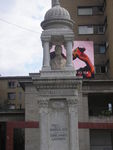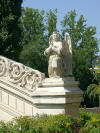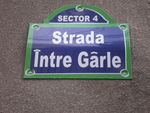Walk with Mihai
Today, having spent a morning teaching and helping Tantza white-wash her little flat, I met Mihai at Pta Romana for a walk with Rosie. We began meandering our way down to str. Ion Campaneanu with the intention of visiting the roads adjacent to Cismigiu. There are some lovely houses there and it's an area I have neglected. We passed a shop full of t'shirts, mugs and shopping bags covered in witty phrases and sayings. I dawdled there a little, in front of the window, wondering if a good present for Lucia and George was to be had inside. 'Do you know who owns that shop?' asked Mihai as we walked away. I didn't. 'Mihai Stânescu', he told me. Mihai Stanescu is a satyric artist. Having checked out his site I can confirm that he is indeed a satyrist, but can also add that he is a very funny man. His cartoons verge from the sublime to the ridiculous and the politically incorrect. Due to the latter, he suffered greatly under the regime. I rushed back to take a photo. http://www.echange-roumanie.com/rire.htm
there a little, in front of the window, wondering if a good present for Lucia and George was to be had inside. 'Do you know who owns that shop?' asked Mihai as we walked away. I didn't. 'Mihai Stânescu', he told me. Mihai Stanescu is a satyric artist. Having checked out his site I can confirm that he is indeed a satyrist, but can also add that he is a very funny man. His cartoons verge from the sublime to the ridiculous and the politically incorrect. Due to the latter, he suffered greatly under the regime. I rushed back to take a photo. http://www.echange-roumanie.com/rire.htm
 From there, we walked down calea Victoriei, crossed the Dâmbovita and made our
From there, we walked down calea Victoriei, crossed the Dâmbovita and made our way to the church of Mihai Voda. It was built in the 16th century by Michael the Brave. To make way for the Civic Centre, the church was moved 279m east on rails, to str. Sapientei 4, and dumped on what looked like a building site up until now - works are underway at last. The church's medieval cloisters and ancillary buildings were demolished. As it's now standing on a concrete platform, it will probably collapse in the event of another earthquake. So tragic. It's a lovely church.
way to the church of Mihai Voda. It was built in the 16th century by Michael the Brave. To make way for the Civic Centre, the church was moved 279m east on rails, to str. Sapientei 4, and dumped on what looked like a building site up until now - works are underway at last. The church's medieval cloisters and ancillary buildings were demolished. As it's now standing on a concrete platform, it will probably collapse in the event of another earthquake. So tragic. It's a lovely church.
 We walked towards Unirii, passing in front of a memorial statue for George Lahovary, dedicated by Princess Zoë de Soutu on Pta National Unité. I've searched and searched to find the connection between these two, but so far have had no luck, except to discover that George had a sister called Zoë. Was it a dedication from his sister, then? If anyone knows, please don't hesitate to let me know.
We walked towards Unirii, passing in front of a memorial statue for George Lahovary, dedicated by Princess Zoë de Soutu on Pta National Unité. I've searched and searched to find the connection between these two, but so far have had no luck, except to discover that George had a sister called Zoë. Was it a dedication from his sister, then? If anyone knows, please don't hesitate to let me know.
We crossed the street further down Bdul D. Cantemir, catching sight of the gorgeous church of Sf. Spiridon Vechi on calea Serban Voda. It was totally destroyed by the communists, and rebuilt exactly as it had been before it's destruction after 1990. It houses Tatterescu paintings dating from 1858.
church of Sf. Spiridon Vechi on calea Serban Voda. It was totally destroyed by the communists, and rebuilt exactly as it had been before it's destruction after 1990. It houses Tatterescu paintings dating from 1858.
The heavens opened, Rosie disappeared under a car seeking refuge from the torrential downpour, and Mihai and I got soaked to the skin trying to coax her out. It would probably have been a better idea to get under the car with her, but we didn't think of it at the time.
 Along str. Radu Voda, Mihai showed me a real gem. The Radu Voda
Along str. Radu Voda, Mihai showed me a real gem. The Radu Voda Monastery. Founded in 1568 it was once the richest monastery in the country with 8342 properties. Also known as Holy Trinity or Sf. Treime, one could be forgiven for thinking one had dropped into Bucovina. Flowers everywhere, brightly coloured gardens, sculpted angels tastefully gracing the flower beds, and oh, what a monastery. Murals, mosaics, and an interior that took my breath away. An atmosphere of utter peace and tranquility envelopped this celestially holy place. Rosie paused to drink rainwater from a very clean gutter. Mihai and I walked
Monastery. Founded in 1568 it was once the richest monastery in the country with 8342 properties. Also known as Holy Trinity or Sf. Treime, one could be forgiven for thinking one had dropped into Bucovina. Flowers everywhere, brightly coloured gardens, sculpted angels tastefully gracing the flower beds, and oh, what a monastery. Murals, mosaics, and an interior that took my breath away. An atmosphere of utter peace and tranquility envelopped this celestially holy place. Rosie paused to drink rainwater from a very clean gutter. Mihai and I walked slowly around the grounds of the monastery, hardly speaking. It was a spell we were loathe to break. The highlight of my walk, for I have discovered yet another little corner of heaven, in this incredibly surprising, rich and awe-inspiring city. Never did I find such a city which fires my imagination and gives a need to know the who's, where's and why's as much as Bucharest.
slowly around the grounds of the monastery, hardly speaking. It was a spell we were loathe to break. The highlight of my walk, for I have discovered yet another little corner of heaven, in this incredibly surprising, rich and awe-inspiring city. Never did I find such a city which fires my imagination and gives a need to know the who's, where's and why's as much as Bucharest.
 Across the road from Radu Voda monastery is the church of Bucur Ciobanul. Wikipedia says it's the oldest church standing in Bucharest and legend says it was first built from wood by Bucur the shepherd. The stone construction was made by Mircea the Elder (Mircea cel Bâtrân) in 1416. Bucur (meaning 'joy') the Shepherd constructed this beautiful little church to give thanks for enabling him to found Bucharest (Bucuresti...or rather, Bucur Esti: the '-esti' is a suffix which was derived from personal names, normally of a landowner or a founder). This can't be true, as Bucharest existed well before Bucur Ciobanul, but it's a nice story! Set on a small hill, it stands slightly back from str. Radu Voda which means you get a perfect and uninterrupted view of it from the road. White and airy, loved by flowers of all colours and variety, it reaches out to you demanding a visit and admiration. I'm a little confused as I thought that Curtea Veche was the oldest church in Bucharest, situated also in the same area, opposite Hanal lui Manuc. Some ressources say Bucur church was built in the first half of the 18th century, around 1743. Others say it was there way before. Hmm...more time required to find out.
Across the road from Radu Voda monastery is the church of Bucur Ciobanul. Wikipedia says it's the oldest church standing in Bucharest and legend says it was first built from wood by Bucur the shepherd. The stone construction was made by Mircea the Elder (Mircea cel Bâtrân) in 1416. Bucur (meaning 'joy') the Shepherd constructed this beautiful little church to give thanks for enabling him to found Bucharest (Bucuresti...or rather, Bucur Esti: the '-esti' is a suffix which was derived from personal names, normally of a landowner or a founder). This can't be true, as Bucharest existed well before Bucur Ciobanul, but it's a nice story! Set on a small hill, it stands slightly back from str. Radu Voda which means you get a perfect and uninterrupted view of it from the road. White and airy, loved by flowers of all colours and variety, it reaches out to you demanding a visit and admiration. I'm a little confused as I thought that Curtea Veche was the oldest church in Bucharest, situated also in the same area, opposite Hanal lui Manuc. Some ressources say Bucur church was built in the first half of the 18th century, around 1743. Others say it was there way before. Hmm...more time required to find out.
 We crossed the road on a Mihai mission to find str. Intre Gârle, the place where the tributories of the original Dâmbovita (so-named after the county with its capital Tîrgoviste), forced underground, separated. It was strange to imagine the river pushed into darkness rushing to the sea under our very feet.
We crossed the road on a Mihai mission to find str. Intre Gârle, the place where the tributories of the original Dâmbovita (so-named after the county with its capital Tîrgoviste), forced underground, separated. It was strange to imagine the river pushed into darkness rushing to the sea under our very feet.
Bucharest folkore mentions the waters of Dâmboviţa as "sweet", and even at the beginning of the 18th century, it was considered "light and clean". However, toward the end of the century, as the population of Bucharest increased, the river ceased to be so, and hence the need of the aqueducts. The earliest aqueducts with public fountains (cişmele) were built during the rule of Alexander Ypsilantis.
Dâmboviţa used to have two tributaries in Bucharest: Dâmbovicioara on the right bank, which probably flowed in what is the area where Sfiinţii Apostoli street is located and Bucureştioara, which rose from a pond located in what is now Parc Icoanei! Additionally, there was a branch, Gârliţa, which formed an island.
The Dâmboviţa often flooded Bucharest, especially the lower left bank, which was lower. After the great 1775 flood, Ypsilantis ordered a branch canal to be built, in order to prevent, or at least diminish the effects of such flooding; in 1813, Prince Jean Georges Caradja decided to clean up the river bed. The portion of the river flowing through the capital was channelled twice: in 1883 (to combat regular floods), and in the late 1970s by Ceausescu, to aid in the replanning of the civic centre and the construction of the Bucharest Metro. So, in fact today, underground runs the true Dâmbovita, while above it as a canal runs the imposter, the 'false' Dâmbovita.
 Another road that Mihai had been keen on discovering, str. Lâpâriei was fairly nearby. When the Dâmbovita was above ground, the women of the area had farmed sheep. They made their living from the meat, cheese and milk and spun wool. They did their washing in the river, rubbing their woollen clothes in its waters. Hence the name of this street. Misto, nu?
Another road that Mihai had been keen on discovering, str. Lâpâriei was fairly nearby. When the Dâmbovita was above ground, the women of the area had farmed sheep. They made their living from the meat, cheese and milk and spun wool. They did their washing in the river, rubbing their woollen clothes in its waters. Hence the name of this street. Misto, nu?
We took the metro back to Pta Romana from Tineretului. Rosie's first trip on the Bucharest Underground can only be described as touching. Although she was very nervous, she remained 'foarte cuminte' as is her docile and adorable nature.
 Thanks to Mihai for such a fascinating tour of this part of Bucharest. It certainly has shown huge holes in my knowledge concerning the city 'de inima mea'. I'll get to it tomorrow.
Thanks to Mihai for such a fascinating tour of this part of Bucharest. It certainly has shown huge holes in my knowledge concerning the city 'de inima mea'. I'll get to it tomorrow.
Now, as Samuel Pepys was said to have announced, 'and so to bed'.
With love, Sarah

/https%3A%2F%2Fstorage.canalblog.com%2F03%2F12%2F353913%2F41915630_o.jpg)
/https%3A%2F%2Fstorage.canalblog.com%2F15%2F06%2F353913%2F41915331_o.jpg)
/https%3A%2F%2Fstorage.canalblog.com%2F03%2F68%2F353913%2F41914713_o.jpg)
/https%3A%2F%2Fstorage.canalblog.com%2F22%2F12%2F353913%2F29890995_o.jpg)
/https%3A%2F%2Fstorage.canalblog.com%2F68%2F41%2F353913%2F29890862_o.jpg)



/https%3A%2F%2Fstorage.canalblog.com%2F08%2F12%2F353913%2F116988178_o.jpg)
/https%3A%2F%2Fstorage.canalblog.com%2F59%2F38%2F353913%2F115811794_o.jpg)
/https%3A%2F%2Fstorage.canalblog.com%2F00%2F54%2F353913%2F113969303_o.jpg)
/http%3A%2F%2Fp8.storage.canalblog.com%2F81%2F17%2F353913%2F59684501_p.jpg)